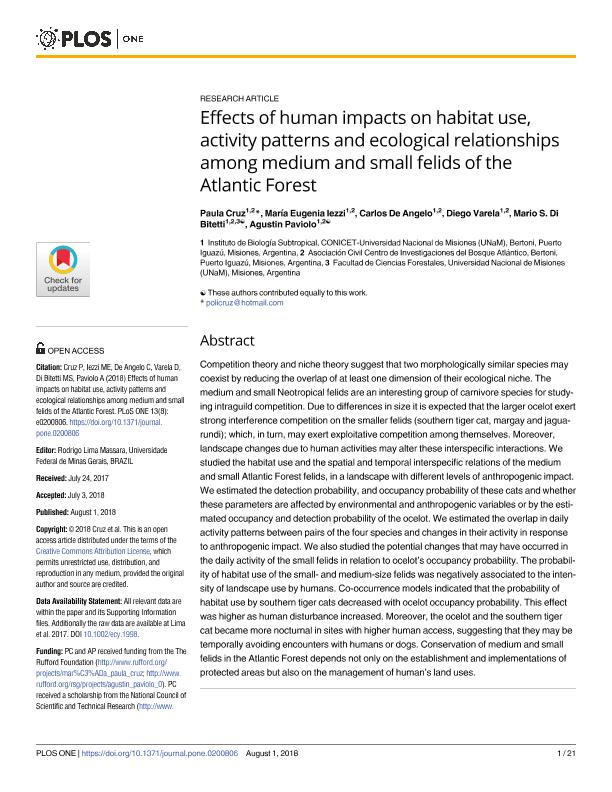Mostrar el registro sencillo del ítem
dc.contributor.author
Cruz, María Paula

dc.contributor.author
Iezzi, María Eugenia

dc.contributor.author
de Angelo, Carlos Daniel

dc.contributor.author
Varela, Diego Varela

dc.contributor.author
Di Bitetti, Mario Santiago

dc.contributor.author
Paviolo, Agustin Javier

dc.date.available
2019-11-26T18:09:53Z
dc.date.issued
2018-08
dc.identifier.citation
Cruz, María Paula; Iezzi, María Eugenia; de Angelo, Carlos Daniel; Varela, Diego Varela; Di Bitetti, Mario Santiago; et al.; Effects of human impacts on habitat use, activity patterns and ecological relationships among medium and small felids of the Atlantic Forest; Public Library of Science; Plos One; 13; 8; 8-2018; 1-21
dc.identifier.issn
1932-6203
dc.identifier.uri
http://hdl.handle.net/11336/90525
dc.description.abstract
Competition theory and niche theory suggest that two morphologically similar species may coexist by reducing the overlap of at least one dimension of their ecological niche. The medium and small Neotropical felids are an interesting group of carnivore species for studying intraguild competition. Due to differences in size it is expected that the larger ocelot exert strong interference competition on the smaller felids (southern tiger cat, margay and jaguarundi); which, in turn, may exert exploitative competition among themselves. Moreover, landscape changes due to human activities may alter these interspecific interactions. We studied the habitat use and the spatial and temporal interspecific relations of the medium and small Atlantic Forest felids, in a landscape with different levels of anthropogenic impact. We estimated the detection probability, and occupancy probability of these cats and whether these parameters are affected by environmental and anthropogenic variables or by the estimated occupancy and detection probability of the ocelot. We estimated the overlap in daily activity patterns between pairs of the four species and changes in their activity in response to anthropogenic impact. We also studied the potential changes that may have occurred in the daily activity of the small felids in relation to ocelot’s occupancy probability. The probability of habitat use of the small- and medium-size felids was negatively associated to the intensity of landscape use by humans. Co-occurrence models indicated that the probability of habitat use by southern tiger cats decreased with ocelot occupancy probability. This effect was higher as human disturbance increased. Moreover, the ocelot and the southern tiger cat became more nocturnal in sites with higher human access, suggesting that they may be temporally avoiding encounters with humans or dogs. Conservation of medium and small felids in the Atlantic Forest depends not only on the establishment and implementations of protected areas but also on the management of human’s land uses.
dc.format
application/pdf
dc.language.iso
eng
dc.publisher
Public Library of Science

dc.rights
info:eu-repo/semantics/openAccess
dc.rights.uri
https://creativecommons.org/licenses/by/2.5/ar/
dc.subject
COMPETITION
dc.subject
FELIDS
dc.subject
ATLANTIC FOREST
dc.subject
OCCUPANCY
dc.subject.classification
Ecología

dc.subject.classification
Ciencias Biológicas

dc.subject.classification
CIENCIAS NATURALES Y EXACTAS

dc.title
Effects of human impacts on habitat use, activity patterns and ecological relationships among medium and small felids of the Atlantic Forest
dc.type
info:eu-repo/semantics/article
dc.type
info:ar-repo/semantics/artículo
dc.type
info:eu-repo/semantics/publishedVersion
dc.date.updated
2019-10-18T15:48:12Z
dc.journal.volume
13
dc.journal.number
8
dc.journal.pagination
1-21
dc.journal.pais
Estados Unidos

dc.journal.ciudad
San Francisco
dc.description.fil
Fil: Cruz, María Paula. Consejo Nacional de Investigaciones Científicas y Técnicas. Centro Científico Tecnológico Conicet - Nordeste. Instituto de Biología Subtropical. Universidad Nacional de Misiones. Instituto de Biología Subtropical; Argentina
dc.description.fil
Fil: Iezzi, María Eugenia. Consejo Nacional de Investigaciones Científicas y Técnicas. Centro Científico Tecnológico Conicet - Nordeste. Instituto de Biología Subtropical. Universidad Nacional de Misiones. Instituto de Biología Subtropical; Argentina
dc.description.fil
Fil: de Angelo, Carlos Daniel. Consejo Nacional de Investigaciones Científicas y Técnicas. Centro Científico Tecnológico Conicet - Nordeste. Instituto de Biología Subtropical. Universidad Nacional de Misiones. Instituto de Biología Subtropical; Argentina
dc.description.fil
Fil: Varela, Diego Varela. Consejo Nacional de Investigaciones Científicas y Técnicas. Centro Científico Tecnológico Conicet - Nordeste. Instituto de Biología Subtropical. Universidad Nacional de Misiones. Instituto de Biología Subtropical; Argentina
dc.description.fil
Fil: Di Bitetti, Mario Santiago. Consejo Nacional de Investigaciones Científicas y Técnicas. Centro Científico Tecnológico Conicet - Nordeste. Instituto de Biología Subtropical. Universidad Nacional de Misiones. Instituto de Biología Subtropical; Argentina
dc.description.fil
Fil: Paviolo, Agustin Javier. Consejo Nacional de Investigaciones Científicas y Técnicas. Centro Científico Tecnológico Conicet - Nordeste. Instituto de Biología Subtropical. Universidad Nacional de Misiones. Instituto de Biología Subtropical; Argentina
dc.journal.title
Plos One

dc.relation.alternativeid
info:eu-repo/semantics/altIdentifier/url/https://journals.plos.org/plosone/article?id=10.1371/journal.pone.0200806
dc.relation.alternativeid
info:eu-repo/semantics/altIdentifier/doi/https://doi.org/10.1371/journal.pone.0200806
Archivos asociados
